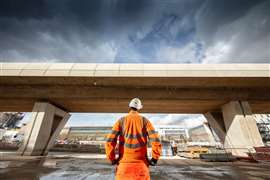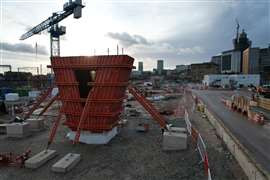The complex temporary works behind a landmark HS2 viaduct
11 October 2024
 A completed section of the Curzon No 3 viaduct on the HS2 high-speed railway in Birmingham, UK (Image: HS2)
A completed section of the Curzon No 3 viaduct on the HS2 high-speed railway in Birmingham, UK (Image: HS2)
A landmark viaduct running into Birmingham’s Curzon Street station on the UK’s HS2 high-speed railway is slowly emerging from a complex ballet of steel, aluminium and concrete.
‘Curzon No. 3 Viaduct’ is a 260m-long, post-tensioned, reinforced concrete structure, with four viaduct decks coming out of the station before merging into a single bridge deck carrying three high-speed tracks.
Work by main contractor Balfour Beatty Vinci (BBV) to build the decks and the 22 V-shaped concrete piers that support them has required a vast and innovative system of temporary works from Altrad RMD Kwikform.
In fact, it was one of the largest projects that Cliff Shepherd, senior project engineer at Altrad RMDK has worked on in his 33-year career. BBV holds two main civil engineering contracts worth a total of £5 billion (US$6.7 billion) on HS2. They involve earthworks, ground engineering, and the design and construction of tunnels and viaducts along a 90km stretch of HS2 in the West Midlands.
Altrad RMDK’s temporary works solution for Curzon No 3, one of the major viaducts BBV is in charge of, has been required to enable a series of separate concrete pours for all the bridge decks.
“It has involved 11 concrete pours with each pour using approximately 900 cubic metres of concrete. In total, that’s almost 10,000 cubic metres of concrete with a total of 290 square metres surface area on the deck,” Shepherd tells Construction Briefing.
“The sheer volume and complexity of coordinating these pours really highlighted the magnitude of the project for me, making it one of the most significant I’ve been part of.”
Innovative design
The falsework configuration needed to be designed in such a way to allow the transfer of the loads from the concrete deck and wind forces down into the foundations without overloading the structure.
Altrad RMDK’s engineers also designed the system so that the site team could easily and safely move the falsework and formwork deck units after each pour, for reuse elsewhere.
 Formwork surrounding a V-shaped pier (Image: Altrad RMDK)
Formwork surrounding a V-shaped pier (Image: Altrad RMDK)
“The falsework and deck side forms were specifically designed for adaptability and mobility, allowing them to be erected on the ground, wheeled into position, and then craned up,” explains Shepherd.
“This adaptability reduces the time needed for installation and also minimises the time contractors spend working at height, which enhances safety and efficiency even after the decks have merged into a single structure.”
 The formwork and falsework system was designed to be moved easily and safely to accommodate multiple concrete pours (Image: Altrad RMDK)
The formwork and falsework system was designed to be moved easily and safely to accommodate multiple concrete pours (Image: Altrad RMDK)
The tight spaces involved and the - at times - unusual form of the structure meant the company also had to innovate.
“This project led to the development of special crank units, 60 of which were designed to be reusable and ensured the perfect angle for the bridge deck wings,” Shepherd said. “ Given the success of these crank units, we plan to take this solution forward and recommend it for future projects.”
The tight radius curves on the underside of the decks and their “rather complicated” rounded corners also meant that the company had to design a special formwork solution, working closely with infrastructure formwork supplier Cordek to achieve precisely the right shape and finish.
To make it as efficient as possible, the engineering team also took the design of the formwork solution close to (but still within) the safe limit – the maximum working load for the falsework legs is eight tonnes, with the design stopping just short of that at 7.85 tonnes.
Collaboration with BBV
Once the solution was signed off, it allowed BBV to start fixing the permanent works, which for the decks involved lifting in sections of prefabricated steel reinforcements and installing polystyrene void formers and post-tensioning ducts ahead of the concrete pours.
“Communication and collaboration with BBV and other companies involved in the project have been essential,” says Shepherd. That involved regular face-to-face and weekly meetings, as well as having a constant presence on site both to strengthen relationships and prevent potential problems.
Construction is now at an advanced stage, with seven deck pours completed and the eighth scheduled for this month (October). The majority of the piers have also already been completed and Altrad RMDK will remain involved until the end of the process.
 An aerial view of early progress on the construction of the V-shaped piers for the Curzon No 3 viaduct in Birmingham, UK (Image: HS2)
An aerial view of early progress on the construction of the V-shaped piers for the Curzon No 3 viaduct in Birmingham, UK (Image: HS2)
Lenka Vošvrdová, senior agent at BBV’s Curzon Street site, describes the completion of the first several sections of the viaduct as a “significant moment” for everyone connected with the project.
“This achievement was only possible thanks to the hard work, skill and expertise demonstrated on a daily basis by the Balfour Beatty VINCI site team and our supply chain partners,” she says.
Shepherd adds, “We’re very proud of our involvement in this project. The most rewarding aspect would be seeing the structure come to life, which comes down to our team’s hard work and collaboration.
“The most challenging part was the design phase, where we had to ensure that there were no clashes with the beams and the falsework, making everything fit together perfectly. Balancing this while keeping the project on track was very satisfying.”
Combining products to create a unique solution
Altrad RMD Kwikform specified several interconnected products for the complex formwork and falsework involved in this project, combining the Rapidshor falsework system with Almform aluminium beams and Superslim Soldier formwork beams to create the formwork cradles.
Slimshor propping with clear span steel beams and further Alform decking beams were used to support the deck soffit over the “V” shaped void in the piers, with Megashor wailings (horizontal beams to support the sides of formwork) to stabilise the side shutters.
A fully braced falsework system was the chosen method of support, with supports at 1.2-metre centres down the length of the viaduct. Altrad RMDK achieved the deck profile with a system of aluminium wailings and Superslim primary beams, which sat on top of the falsework and incorporated a cantilevered support to the wings of the deck. By ensuring the structure was then internally supported, there was no need for external props to the ground.
CONNECT WITH THE TEAM









